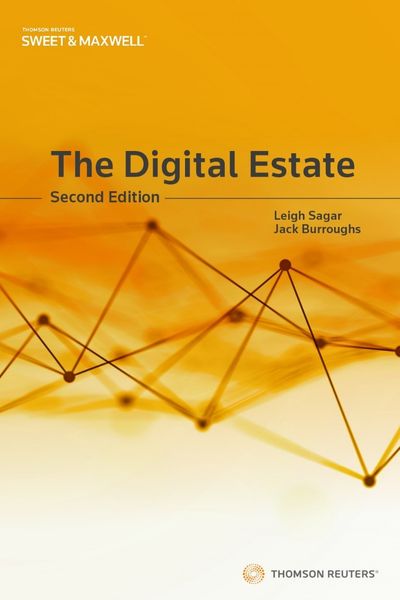The Digital Estate provides an analysis of the rights and liabilities associated with digital information passing from, to and through computing and other devices owned and controlled by fiduciaries, including trustees, personal representatives, lasting and other attorneys.
Key Features
- A practical guide to the administration of digital assets
- The book provides an analysis of the rights and liabilities associated with digital information passing from, to and through computing and other devices owned and controlled by fiduciaries, including trustees, personal representatives, and lasting and other attorneys.
- Provides practical solutions to the problems that the individual and his personal representatives may face in securing succession to assets and safe transmission of information that may otherwise be deleted, locked or lost.
- Guides the practitioner through pre-death preventative measures relating to wills.
- Considers the issues that arise when an individual who owns assets or stores information on-line, dies
- Covers steps to be taken during probate for the administration of digital assets
- Covers specific roles in administration including personal representatives, trustees and agents and attorneys
- Includes clear practical guidance on the actions that should be taken or considered in the administration of digital information or assets including a useful section on drafting for the digital estate featuring precedents for will drafting, trusts and Lasting Powers of Attorney
- Considers the issues relevant to trust investments in cryptoassets
- Examines the principles of English law that define the proprietary nature of information, taking into account the approach to this issue in other jurisdictions, such as the United States, Australia and New Zealand
- Identifies the property rights that are associated with information and examine their operation. These include intellectual property rights, contractual rights, and other rights, including to cryptoassets such as bitcoin and non-fungible tokens (NFTs)
- Includes a straightforward technical explanations of relevant technologies including blockchains,
- Decentralised Finance (DeFi), and public/private key cryptography.
- Investigates the principles applicable to the use of digital information that has no proprietary status.
- Analyses the regulatory consequences of the control or use of digital information, including data protection, financial regulation and computer misuse.
- Provides an analysis of the different approaches to determining the location of cryptoassets
- Analyses the personal tax consequences of cryptoasset transactions and DeFi.
- Examines the law around digital documents, and digital execution of documents, including developments arising as a result of the COVID-19 pandemic
New to this edition:
- Three new chapters on Distributed ledger technology, decentralised digital assets and decentralised finance.
- New sections analyzing the application of property law to cryptoassets, examining the personal tax consequences of cryptocurrency and DeFi transactions, and considering the situs of cryptoassets
- A considerable body of new case law and official reports that have emerged since the first edition such as Lloyd v Google LLC [2021] UKSC 50; Warner Music UK Ltd v TuneIn, Inc. [2021] EWCA Civ 441; Fetch.ai Ltd v Persons Unknown [2021] EWHC 2254 (Comm); Quoine Pte Ltd v B2C2 Ltd [2020] SGCA(I) 02 to name a few.
- Recent legislative changes such as the General Data Protection Regulation and Data Protection Act 2018; Wills Act 1837 (Electronic Communications) (Amendment) (Coronavirus) Order 2020/952 and the Trade Secrets (Enforcement, etc.) Regulations 2018.

